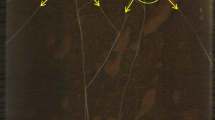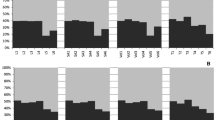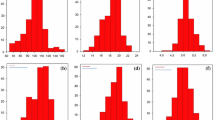Abstract
Root architecture traits in wheat are important in deep soil moisture acquisition and may be used to improve adaptation to water-limited environments. The genetic architecture of two root traits, seminal root angle and seminal root number, were investigated using a doubled haploid population derived from SeriM82 and Hartog. Multiple novel quantitative trait loci (QTL) were identified, each one having a modest effect. For seminal root angle, four QTL (−log10(P) >3) were identified on 2A, 3D, 6A and 6B, and two suggestive QTL (−log10(P) >2) on 5D and 6B. For root number, two QTL were identified on 4A and 6A with four suggestive QTL on 1B, 3A, 3B and 4A. QTL for root angle and root number did not co-locate. Transgressive segregation was found for both traits. Known major height and phenology loci appear to have little effect on root angle and number. Presence or absence of the T1BL.1RS translocation did not significantly influence root angle. Broad sense heritability (h 2) was estimated as 50 % for root angle and 31 % for root number. Root angle QTL were found to be segregating between wheat cultivars adapted to the target production region indicating potential to select for root angle in breeding programs.


Similar content being viewed by others
References
Andrews JL, Blundell MJ, Skerritt JH (1996) Differentiation of wheat-rye translocation lines using antibody probes for Gli-B1 and Sec-1. J Cereal Sci 23:61–72
Diversity Array Technology Pty. Ltd. http://www.triticarte.com.au. Accessed March 20 2011
Bassam BJ, Caetano-Anollés G (1993) Automated “hot start” PCR using mineral oil and paraffin wax. Biotechniques 14:30–34
Bengough AG, Gordon DC, Al-Menaie H, Ellis RP, Allan D, Keith R, Thomas WTB, Forster BP (2004) Gel observation chamber for rapid screening of root traits in cereal seedlings. Plant Soil 262:63–70
Borrell AK, Incoll LD, Dalling MJ (1991) The influence of the Rht 1 and Rht 2 alleles on the growth of wheat stems and ears. Ann Bot 67:103–110
Butler DG, Cullis BR, Gilmour AR, Gogel BJ (2009) ASReml-R reference manual version 3. Department of Primary Industries and Fisheries, Brisbane
Champoux MC, Wang G, Sarkarung S, Mackill DJ, O’Toole JC, Huang N, McCouch SR (1995) Locating genes associated with root morphology and drought avoidance in rice via linkage to molecular markers. Theor Appl Genet 90:969–981
Chenu K, Cooper M, Hammer GL, Mathews KL, Dreccer F, Chapman SC (2011) Environment characterization as an aid to wheat improvement: interpreting genotype-environment interactions by modelling water-deficit patterns in North-Eastern Australia. J Exp Bot 62:1743–1755
Christopher JT, Manchadi AM, Hammer GL, Borrell AL (2008) Developmental and physiological traits associated with high yield and stay-green phenotype in wheat. Aust J Agric Res 59:354–364
Cooper M, Jensen NM, Carroll BJ, Godwin ID, Podlich DW (1999) QTL mapping activities and marker assisted selection for yield in the Germplasm Enhancement Program of the Australian Northern Wheat Improvement Program. In: Ribaut JM, Poland D (eds) Molecular approaches for the genetic improvement of cereals for stable production in water-limited environments. CIMMYT, El Batan, Mexico, pp 120–127
Crossa J, Burgeno J, Dreisigacker S, Vargas M, Herrera-Foessel SA, Lillemo M, Singh RP, Trethowan R, Warburton M, Francno J, Reynolds M, Crouch JH, Ortiz R (2007) Association analysis of historical bread wheat germplasm using additive genetic covariance of relatives and population structure. Genetics 177:1889–1913
de Dorlodot S, Forster B, Pagé L, Price A, Tuberosa R, Draye X (2007) Root system architecture: opportunities and constraints for genetic improvement of crops. Trends Plant Sci 12:474–481
Eagles HA, Cane K, Vallance N (2009) The flow of alleles of important photoperiod and vernalisation genes through Australian wheat. Crop Pasture Sci 60:646–657
Ehdaie B, Waines JG (2008) Larger root system increases water-nitrogen uptake and grain yield in bread wheat. In: Appels R et al. (eds) 11th International Wheat Genetics Symposium, Brisbane, Queensland, Australia http://hdl.handle.net/2123/3293
Ehdaie B, Whitkus RW, Waines JG (2003) Root biomass, water-use efficiency, and performance of wheat-rye translocations of chromosomes 1 and 2 in spring bread wheat ‘Pavon’. Crop Sci 43:710–717
Giuliani S, Sanguineti MC, Tuberosa R, Bellotti M, Salvi S, Landi P (2005) Root-ABA1, a major constitutive QTL, affects maize root architecture and leaf ABA concentration at different water regimes. J Exp Bot 56:3061–3070
Guingo E, Hébert Y, Charcosset A (1998) Genetic analysis of root traits in maize. Agronomie 18:225–235
Hamada A, Nitta M, Nasuda S, Kato K, Fujita M, Matsunaka H, Okumoto Y (2012) Novel QTLs for growth angle of seminal roots in wheat (Triticum aestivum L.). Plant Soil 354:395–405
Hammer GL, Dong Z, McLean G, Doherty A, Messina C, Schussler J, Zineslmeier C, Paszkiewicz S, Cooper M (2009) Can changes in canopy and/or root system architecture explain historical maize yield trends in the US corn belt. Crop Sci 49:299–312
Hund A, Ruta N, Liedgens M (2009) Rooting depth and water use efficiency of tropical maize inbred lines, differing in drought tolerance. Plant Soil 318:311–325
Kirkegaard JA, Lilley JM, Howe GN, Graham JM (2007) Impact of subsoil water use on wheat yield. Aust J Agric Res 58:303–315
Lowe I, Jankuloski L, Chao S, Chen X, See D, Dubcovsky J (2011) Mapping and validation of QTL which confer partial resistance to broadly virulent post-2000 North American races of stripe rust in hexaploid wheat. Theor Appl Genet 123:143–157
Ludlow MM, Muchow RC (1990) A critical evaluation of traits for improving crop yields in water-limited environments. Adv Agron 43:107–153
Mace ES, Singh V, van Oosterom EJ, Hammer GL, Hunt CH, Jordan DR (2012) QTL for nodal root angle in sorghum (Sorghum bicolour L. Moench) co-locate with QTL for traits associated with drought adaptation. Theor Appl Genet 124:97–109
Manschadi AM, Christopher JT, de Voil P, Hammer GL (2006) The role of root architectural traits in adaptation of wheat to water-limited environments. Funct Plant Biol 33:823–837
Manschadi AM, Hammer GL, Christopher JT, de Voil P (2008) Genotypic variation in seedling root architectural traits and implications for drought adaptation in wheat (Triticum aestivum L.). Plant Soil 303:115–129
Manschadi AM, Christopher JT, Hammer GL, deVoil P (2010) Experimental and modelling studies of drought-adaptive root architectural traits in wheat (Triticum aestivum L.). Plant Biosyst 144:458–462
Manske GGB, Vlek PLG (2002) Root architecture – wheat as a model plant. In: Waisel Y, Eshel A, Kafkafi U (eds) Plant roots: the hidden half. Dekker, New York, pp 249–259
Mathews KL, Malosetti M, Chapman SC, McIntyre CL, Reynolds M, Shorter R, van Eeuwijk F (2008) Multi-environment QTL mixed models for drought stress adaptation in wheat. Theor Appl Genet 117:1077–1091
McLaren CG, Ramos L, Lopez C, Eusebio W (2004) Applications of the genealogy management system. ICIS Technical Manual
Nakamoto T, Oyanagi A (1996) The configuration of the seminal roots of Triticum aestivum L. (Poaceae). J Plant Res 109:375–380
Nakamoto T, Shimoda K, Matsuzaki A (1991) Elongation angle of nodal roots and its possible relation to spatial root distributuion in maize and foxtail millet. Jpn J Crop Sci 60:543–549
Norton GJ, Price AH (2009) Mapping of quantitative trait loci for seminal root morphology and gramitropic response in rice. Euphytica 166:229–237
Olivares-Villegas JJ, Reynolds MP, McDonald GK (2007) Drought-adaptive attributes in the Seri/Babax hexaploid wheat populations. Funct Plant Biol 34:189–203
Omori F, Mano Y (2007) QTL mapping of root angle in F2 populations from maize ‘B73’ × teosinte ‘Zea luxurians’. Plant Root 1:57–65
Oyanagi A, Sato A, Wada M, Yamada T (1991) Inheritance of geotropic responses in wheat seminal roots. Jpn J Breed 41:181–184
Oyanagi A, Nakamoto T, Wada M (1993) Relationship between root growth angle of seedlings and vertical distribution of roots in the field in wheat cultivars. Jpn J Crop Sci 62:565–570
Oyanagi A, Kiribuchi-Otobe C, Yanigisawa T, Honda I, Wada M (2001) Selection of wheat experimental lines with deep and shallow root systems based on the growth angle of seminal roots. Jpn J Crop Sci 70:400–407
Passioura JB (1972) The effect of root geometry on the yield of wheat growing on stored water. Aust J Agric Res 23:745–752
Peake A (2003) Inheritance of grain yield and effect of the 1BL/1RS translocation in three bi-parental wheat (Triticum aestivum L.) populations in production environments of north eastern Australia. PhD Thesis, School of Land and Food Sciences, University of Queensland, Brisbane
Peake AS, Cooper M, Fabrizius MA (1996) The relationship between the 1BL/1RS translocation and grain yield for three wheat populations in Queensland environments. In: Richards RA et al (eds) 8th assembly of the Wheat Breeding Society of Australia. Wheat Breeding Society of Australia, Canberra, pp P20–P23
Peake AS, Gilmour A, Cooper M (2011) The 1BL/1RS translocation decreases grain yield of spring wheat germplasm in low yield environments of north-eastern Australia. Crop Pasture Sci 62:276–288
R Development Core Team (2009) R: a language and environment for statistical computing. R Foundation for Statistical Computing, Vienna, Austria
Rajaram S, Mann CE, Oritz-Ferrara G, Mujeeb-Kazi A (1983) Adaptation, stability and high yield potential of certain 1B/1R CIMMYT wheats. In: Sakamoto S (ed) The 6th international wheat genetics symposium. CIMMYT, Mexico City, Kyoto, Japan, pp 613–621
Rattey A, Shorter R, Chapman S, Dreccer F, van Herwaarden A (2009) Variation for and relationships among biomass and grain yield component traits conferring improved yield and grain mass in an elite wheat population grown in variable yield environments. Crop Pasture Sci 60:717–729
Rebetzke GJ, Ellis MH, Bonnett DG, Mickelson B, Condon AG, Richards RA (2012) Height reduction and agronomic performance for selected gibberellin-responsive dwarfing genes in bread wheat (Triticum aestivum L.). Field Crop Res 126:87–96
Ren Y, He X, Liu D, Li J, Zhao X, Li B, Tong Y, Zhang A, Li Z (2012) Major quantitative trait loci for seminal root morphology of wheat seedlings. Mol Breed 30:139–148
Richards RA, Rebetzke GJ, Watt M, Condon AG, Spielmeyer W, Dolferus R (2010) Breeding for improved water productivity in temperate cereals: phenotyping, quantitative trait loci, markers and the selection environment. Funct Plant Biol 37:85–97
Sanguineti MC, Li S, Maccaferri M, Corneti S, Rotondo F, Chiari T, Tuberosa R (2007) Genetic dissection of seminal root architecture in elite durum wheat germplasm. Ann Appl Biol 151:291–305
Sharma S, Bhat PR, Ehdaie B, Close TJ, Lukaszewski AJ, Waines JG (2009) Integrated genetic map and genetic analysis of a region associated with root traits on the short arm of rye chromosome 1 in bread wheat. Theor Appl Genet 119:783–793
Sharma S, Xu S, Ehdaie B, Hoops A, Clsoe TJ, Lukaszewski AJ, Waines JG (2011) Dissection of QTL effects for root traits using a chromosome arm-specific mapping population in bread wheat. Theor Appl Genet 122:759–769
Sherman JD, Weaver DK, Hofland M, Sing SE, Buteler M, Lanning SP, Naruoka Y, Blake NK, Martin JM, Lamb PF, Carlson GR, Talbert LE (2010) Identification of novel QTL for sawfly resistance in wheat. Crop Sci 50:73–86
Singh R, Matus-Cadiz M, Baga M, Hucl P, Chibbar RN (2010) Identification of genomic regions associated with seed dormancy in white-grained wheat. Euphytica 174:391–408
Singh V, van Oosterom EJ, Jordan DR, Hammer G (2012) Genetic control of nodal root angle in sorghum and its implications on water extraction. E J Agron 42:3–10
Sivapalan S, O’Brien L, Ortiz-Ferrara G, Hollamby GJ, Barclay I, Martin PJ (2001) Yield performance and adaptation of some Australian and CIMMYT/ICARDA developed wheat genotypes in the West Asia North Africa (WANA) region. Aust J Agric Res 52:661–670
Sivapalan S, O’Brien L, Ortiz-Ferrara G, Hollamby GJ, Barclay I, Martin PJ (2003) A comparative study for yield performance and adaptation of some Australian and CIMMYT/ICARDA wheat genotypes grown at selected locations in Australia and the WANA region. Aust J Agric Res 54:91–100
Song QJ, Shi JR, Singh S, Fickus EW, Costa JM, Lewis J, Gill BS, Ward R, Cregan PB (2005) Development and mapping of microsatellite (SSR) markers in wheat. Theorl Appl Genet 110:550–560
Steele KA, Price AH, Shashidhar HE, Witcombe JR (2006) Marker-assisted selection to introgress rice QTLs controlling root triats into an Indian upland rice variety. Theor Appl Genet 112:208–221
Tsilo TJ, Hareland GA, Simsek S, Chao S, Anderson JA (2010) Genome mapping of kernel characteristics in hard red spring wheat breeding lines. Theor Appl Genet 121:717–730
Tuberosa R, Salvi S, Sanguineti MC, Landi P, Maccaferri M, Conti S (2002a) Mapping QTLs regulating morpho-physiological traits and yield: case studies, shortcomings and perspectives in drought-stressed maize. Ann Bot 89:941–963
Tuberosa R, Sanguineti MC, Landi P, Giuliani MM, Salvi S, Conti S (2002b) Identification of QTLs for root characteristics in maize grown in hydroponics and analysis of their overlap with QTLs for grain yield in the field at two water regimes. Plant Mol Biol 48:697–712
Tuberosa R, Giuliani S, Parry MAJ, Araus JL (2007) Improving water use efficiency in Mediterranean agriculture: what limits the adoption of new technologies? Ann Appl Biol 150:157–162
Uga Y, Okuno K, Yano M (2011) Dro1, a major QTL involved in deep rooting of rice under upland field conditions. J Exp Bot 62:2485–2494
Uphaus J, Walker E, Shankar M, Golzar H, Loughman R, Francki M, Ohm H (2007) Quantitative trait loci identified for resistance to stagonospora glume blotch in wheat in the USA and Australia. Crop Sci 47:1813–1822
Vadez V, Deshpande SP, Kholova J, Hammer GL, Borrell AK, Talwar HS, Hash CT (2011a) Stay-green quantitative trait loci’s effects on water extraction, transpiration efficiency and seed yield depend on recipient parent background. Funct Plant Biol 38:553–566
Vadez V, Krishnamurthy L, Hash CT, Upadhyaya HD, Borrell AK (2011b) Yield, transpiration efficiency, and water-use variations and their interrelationships in the sorghum reference collection. Crop Pasture Sci 62:645–655
van Eeuwijk FA, Boer MP, Totir LR, Bink M, Wright D, Winkler CR, Podlich D, Boldman K, Baumgarten A, Smalley M, Arbelbide M, ter Braak CJF, Cooper M (2010) Mixed model approaches for the identification of QTLs within a maize hybrid breeding program. Theor Appl Genet 120:429–440
VSN International (2011) GenStat for Windows, 14th edn. VSN International, Hemel Hempstead, UK. URL: http://GenStat.co.uk
Waines JG, Ehdaie B (2007) Domestication and crop physiology: roots of green-revolution wheat. Ann Bot 100:991–998
Wang S, Basten CJ, Zeng Z-B (2011a) Windows QTL Cartographer 2.5. Department of Statistics, North Carolina State University, Raleigh, NC (http://statgen.ncsu.edu/qtlcart/WQTLCart.htm)
Wang YY, Sun X, Zhao Y, Kong FM, Guo Y, Zhang GZ, Pu YY, Wu K, Li SS (2011b) Enrichment of a common wheat genetic map and QTL mapping for fatty acid content in grain. Plant Sci 181:65–75
Wenzl P, Carling J, Kudrna D, Jaccoud D, Huttner E, Kleinhofs A, Kilian A (2004) Diversity Arrays Technology (DArT) for whole-genome profiling of barley. Proc Natl Acad Sci 101:9915–9920
Whitaker D, Williams ER, John JA (2002) CycDesigN version 2: A package for the computer generation of experimental designs. CSIRO, Canberra, Australia
Yadav R, Courtois B, Huang N, McLaren G (1997) Mapping genes controlling root morphology and root distribution in a doubled-haploid population of rice. Theor Appl Genet 94:619–632
Zhang X, Yang S, Zhou Y, He Z, Xia X (2006) Distribution of the Rht-B1b, Rht-D1b and Rth8 reduced height genes in autumn-sown Chinese wheats detected by molecular markers. Euphytica 152:109–116
Zwart S, Thompson JP, Milgate AW, Bansal UK, Williamson PM, Raman H, Bariana HS (2010) QTL mapping of multiple foliar disease and root-lesion nematode resistances in wheat. Mol Breed 26:107–124
Acknowledgments
We would like to thank Dr. Mark Dieters for supplying the seed for the SeriM82 × Hartog doubled haploid population and Dr. Alan Peake for making available data on the T1BL/1RS translocation status of these lines. Thanks also to Dr. David Butler for statistical assistance and advice. We would also like to thank the Grains Research and Development Corporation (GRDC), the Queensland State Government and the University of Queensland, Queensland Alliance for Agriculture and Food Innovation (QAAFI) for funding this research.
Author information
Authors and Affiliations
Corresponding author
Additional information
Communicated by F. Hochholdinger.
Electronic supplementary material
Below is the link to the electronic supplementary material.
Rights and permissions
About this article
Cite this article
Christopher, J., Christopher, M., Jennings, R. et al. QTL for root angle and number in a population developed from bread wheats (Triticum aestivum) with contrasting adaptation to water-limited environments. Theor Appl Genet 126, 1563–1574 (2013). https://doi.org/10.1007/s00122-013-2074-0
Received:
Accepted:
Published:
Issue Date:
DOI: https://doi.org/10.1007/s00122-013-2074-0




